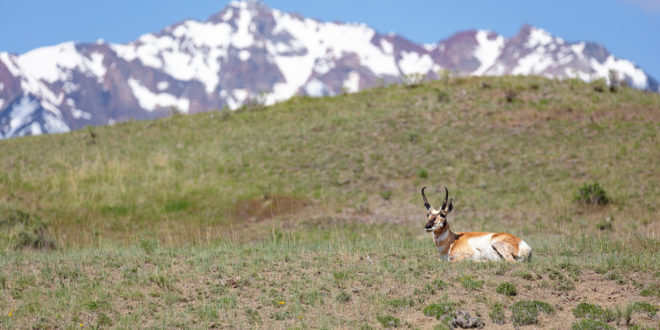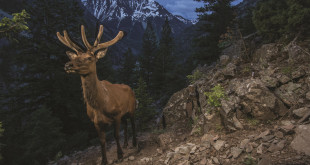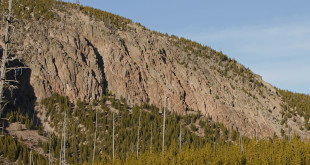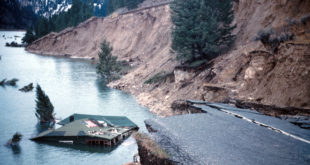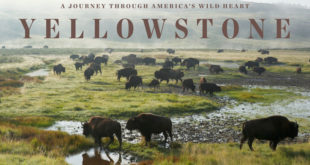Journalist Josh Elliott and animal expert Chris Packham return to host Yellowstone Live, a four-day event running on the National Geographic and Nat Geo Wild cable networks.
Yellowstone Live launched last summer, attracting 13 million viewers in the process. It returns Sunday, June 23, at 8 p.m. Mountain on both National Geographic and Nat Geo Wild, and premieres the following three nights at 7 p.m. Mountain. For those who missed the 2018 debut, Yellowstone Live dispatches camera crews across most of Yellowstone National Park snd surrounding areas.
Returning to co-host the live broadcast is Josh Elliott (CBS News, “Good Morning America”), and animal expert, zoologist and naturalist Chris Packham (“Earth Live”), both reporting live from National Geographic’s wilderness home base at West Yellowstone’s Bar N Ranch. Jenna Wolfe (“First Things First,” “Today”) serves as the roving reporter throughout the live programming.
As roving reporter, Wolfe appears from the American Prairie Reserve (APR) in northeastern Montana, a partner of one of National Geographic’s Last Wild Places initiative partners, which aims to protect the places that sustain life on Earth, with a goal of protecting 30 percent of the planet by 2030. APR is one of the world’s remaining wild intact prairie grasslands and is working to create the largest wildlife reserve in the lower 48 states. Wolfe is stationed on the ground to cover all the action as researchers and animal experts track and study bison, relocate prairie dogs into new habitats and release rescued birds of prey back into the wild. Elliott, Wolfe and Packham, supported by eight live crews, give viewers unprecedented access to prime locations throughout the Greater Yellowstone Ecosystem–from the Gallatin Mountain Range, Lamar Valley, Grand Prismatic Spring to Old Faithful and many more iconic and hidden locations.
Yellowstone Live brings back Emmy Award-winning cinematographer Bob Poole (“Earth Live”) and wildlife cinematographer Susan Gibson (“Planet Earth II”) to showcase the park’s spectacular landscapes and wildlife. Based in the northern part of Yellowstone, Poole plans to capture footage of herds of bison and elk with their newborns as they take their first steps and try to cross fast-flowing rivers while Gibson sets her sights on Grizzly 399 and her two cubs in Grand Teton National Park. Both Poole and Gibson guide viewers with real-time narration while the animals forage for food and try to evade deadly predators. Emmy Award-winning cinematographer Jeff Hogan (“Wild Yellowstone”) is also on tap; the renowned crew sets out to track elusive animals, such as cougars and their cubs and the area’s largest wolfpack, the Wapiti.
Here are some highlights and new features set for the 2019 broadcast;
- Burrow Cam: At American Prairie Reserve, an area not covered in last year’s broadcast, crews employ a unique “Burrow Cam” to show live footage of prairie dogs in their underground homes. Wolfe assists the team in moving and releasing a family group of as many as 20 prairie dogs into its new wild home.
- Bison Cam: At American Prairie Reserve, the live production and National Geographic’s Labs teams fit cameras to America’s heaviest land mammal– the bison–offering a unique perspective of this exalted animal with the “Bison Cam.”
- Beaver Den: Infrared camera technology gives a personal look at a beaver family inside its lodge as parents keep their home safe while attending to their kits’ every need.
- Eagle Nest: Using fixed-rig cameras, the broadcast follows a bald eagle family as busy parents rush to feed hungry chicks preparing to leave the safety of their nests for the first time.
- Grizzly & Wolf Discovery Center: Cameras return to the sanctuary to test the abilities of bears with new stunts and challenges.
- Yellowstone After Dark: The action doesn’t stop when Yellowstone Live goes off air each of the live four nights. A specialist wildlife team heads into the darkness to film ‘Yellowstone After Dark,’ with a state-of-the-art SELEX system thermal camera. Developed for military use, it allows the crew, for the first time, to film Yellowstone at night in close-up detail when some of its most elusive creatures are at their most active.
Photo of pronghorn buck resting in Electric Peak-area meadow by Jacob W. Frank, National Park Service.
 Yellowstone Insider Your Complete Guide to America's First National Park
Yellowstone Insider Your Complete Guide to America's First National Park
